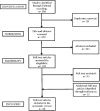Management of Mild Brain Trauma in the Elderly: Literature Review
- PMID: 33708648
- PMCID: PMC7869288
- DOI: 10.4103/ajns.AJNS_205_20
Management of Mild Brain Trauma in the Elderly: Literature Review
Abstract
Purpose: The world population is aging. As direct consequence, geriatric trauma is increasing both in absolute number and in the proportion of annual admissions causing a challenge for the health-care system worldwide. The aim of this review is to delineate the specific and practice rules for the management of mild brain trauma in the elderly.
Methods: Systematic review of the last 15 years literature on mild traumatic brain injury (nTBI) in elderly patients.
Results: A total of 68 articles met all eligibility criteria and were selected for the systematic review. We collected 29% high-quality studies and 71% low-quality studies.
Conclusion: Clinical advices for a comprehensive management are provided. Current outcome data from mTBIs in the elderly show a condition that cannot be sustained in the future by families, society, and health-care systems. There is a strong need for more research on geriatric mild brain trauma addressed to prevent falls, to reduce the impact of polypharmacy, and to define specific management strategies.
Keywords: Brain trauma; elderly; head injury; head trauma; mild brain trauma.
Copyright: © 2020 Asian Journal of Neurosurgery.
Conflict of interest statement
There are no conflicts of interest.
Figures



References
-
- Werman HA, Erskine T, Caterino J, Riebe JF, Valasek T Members of the Trauma Committee of the State of Ohio EMS Board. Development of statewide geriatric patients trauma triage criteria. Prehosp Disaster Med. 2011;26:170–9. - PubMed
-
- Bruns J, Jr, Hauser WA. The epidemiology of traumatic brain injury: A review. Epilepsia. 2003;44:2–10. - PubMed
-
- de Guise E, LeBlanc J, Dagher J, Tinawi S, Lamoureux J, Marcoux J, et al. Traumatic brain injury in the elderly: A level 1 trauma centre study. Brain INJ. 2015;29:558–64. - PubMed
-
- Adams SD, Holcomb JB. Geriatric trauma. Curr Opin Crit Care. 2015;21:520–526. doi:10.1097/MCC.0000000000000246. - PubMed
-
- van den Brand CL, Karger LB, Nijman ST, Hunink MG, Patka P, Jellema K. Traumatic brain injury in the Netherlands, trends in emergency department visits, hospitalization and mortality between 1998 and 2012. Eur J Emerg Med. 2018;25:355–61. - PubMed
Publication types
LinkOut - more resources
Full Text Sources
Research Materials
Miscellaneous

